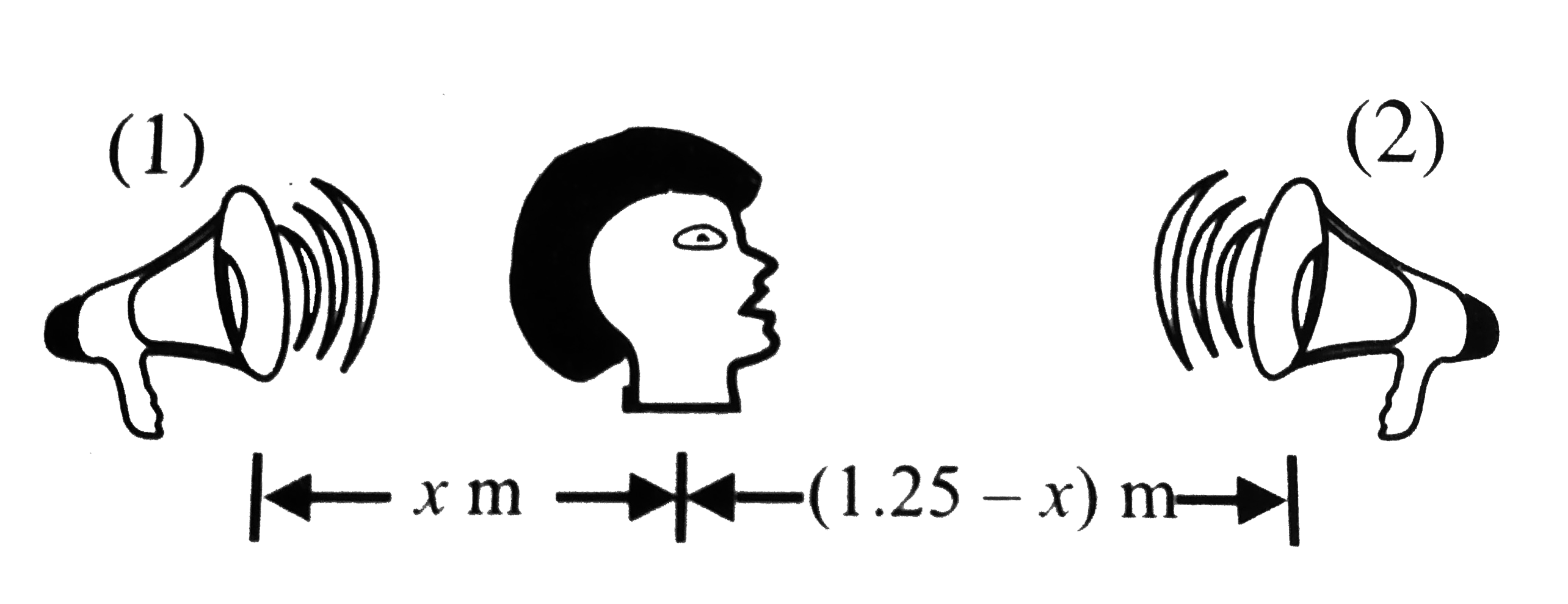Illustration from CENGAGE PHYSICS (HINGLISH) Chapter 11:SUPERPOSITION AND STANDING WAVES for Class 11
| Class 11 | PHYSICS |
| Chapter | SUPERPOSITION AND STANDING WAVES |
| CENGAGE PHYSICS (HINGLISH) | Illustration |
| Medium | English |
| Academic Year | 2023-2024 |
Question 3
Two travelling sinusoidal waves described by the wave functions
y1=(5.00m)sin[π(4.00x−1200t)]
and y2=(5.00m)sin[π(4.00x−1200t−0.250)]
Where x,y1andy2 are in metres and t is in seconds. (a) what is the amplitude of the resultant wave ? (b) What is the frequency of resultant wave ?View SolutionQuestion 4
Two sounds sources of same frequency produce sound intensities I0and4I0 at a point P when used separately . Now , they are used together so that the sound waves from the reach P with a phase difference ϕ. Determine the resultant intensity at P for
(i) ϕ=0 (ii) ϕ=2π/3 (iii) ϕ=πView SolutionQuestion 5
Two identical sources of sound S1andS2 produce intensity I0 at a point P equidistant from each source .
(i) Determine the intensity of each at the point P.
(ii) If the power of S1 is reduced to 64% and phase difference between the two sources is varied continuously , then determine the maximum and minimum intensities at the point P.
(iii) If the power of S1 is reduced by 64% , then determine the maximum and minimum intensities at the point P.View SolutionQuestion 6
Two stereo speaks S1andS2 are separated by a distance of 2.40m. A person (P) is at a distance of 2.40m. A person (P) is at a distance of 3.20m directly in front of one of the speakers as shown in Fig. 7.8. Find the frequencies in the audible range (20−20,000Hz) for which the listener will hear a minimum sound intensity . Speed of sound in air = 320 m//s.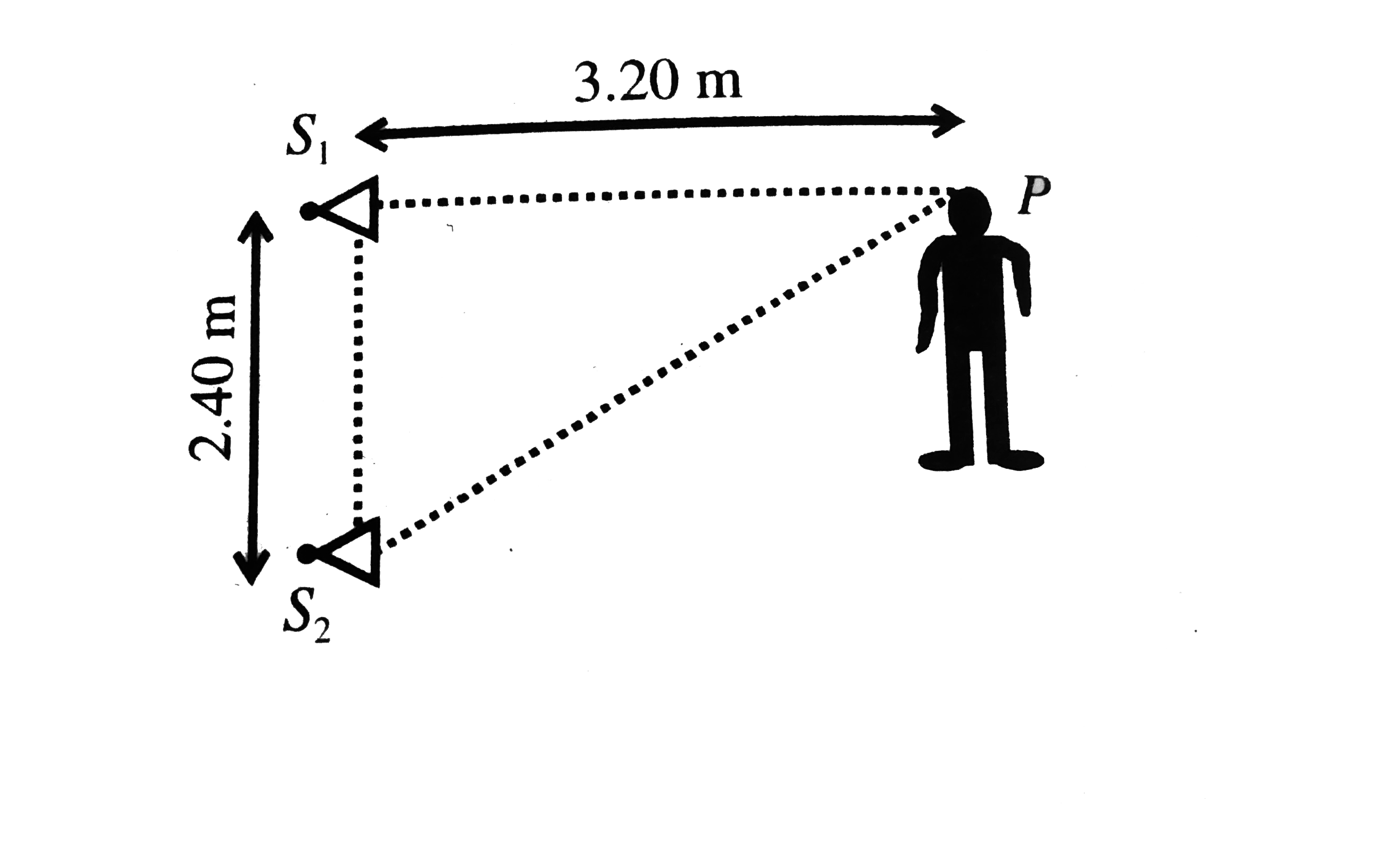 View Solution
View SolutionQuestion 7
Two speakers S1andS2 derived by the same amplifier and placed at y=1.0mandy=−1.0m (Fig . 7.9) The speakers vibrate in phase at 600Hz. A man stands at a point on the x - axis at a very large distance from the origin and starts moving parallel to the Y - axis . The speed of sound in air is 330m/s.
(a). At what angle will the intensity of sound drop to a minimum for the first time ?
(b) At what angle will the sound intensity be maximum for the first time ?
(c ) If he continues to walk along the line , how many more maxima can he hear ?
 View Solution
View SolutionQuestion 9
In an experiment related to interference , Quinck's tube was employed to determine the speed of sound in air. A tunning fork of frequency 1328Hz was used as the sounding source . Initially , the apparatus , yielded a maximum sound intensity . Later , when the slidable tube was drawn by a distance of 12.5cm, the intensity was found to be maximum for the first time . Determine the speed of sound in air .View SolutionQuestion 10
Two identical loudspeakers placed 3.00m apart are driven by the same oscillator as shown in Fig. 7.12. A listener is originally at point O , located 8.00m from the centre of the line connecting the two speakers. The listener then moves to point P, which is a perpendicular distance 0.350m from O , and she experiences the first minimum sound intensity . What is the frequency of the oscillator ?
 View Solution
View SolutionQuestion 11
A string of length 20cm and linear mass density 0.40g/cm is fixed at both ends and is kept under a tension of 16N . A wave pulse is produced at t=0 near an ends as shown in Fig. 7.17 (b) , which travels towards the other end . When will the string have the shape shown in the Fig . ( c).
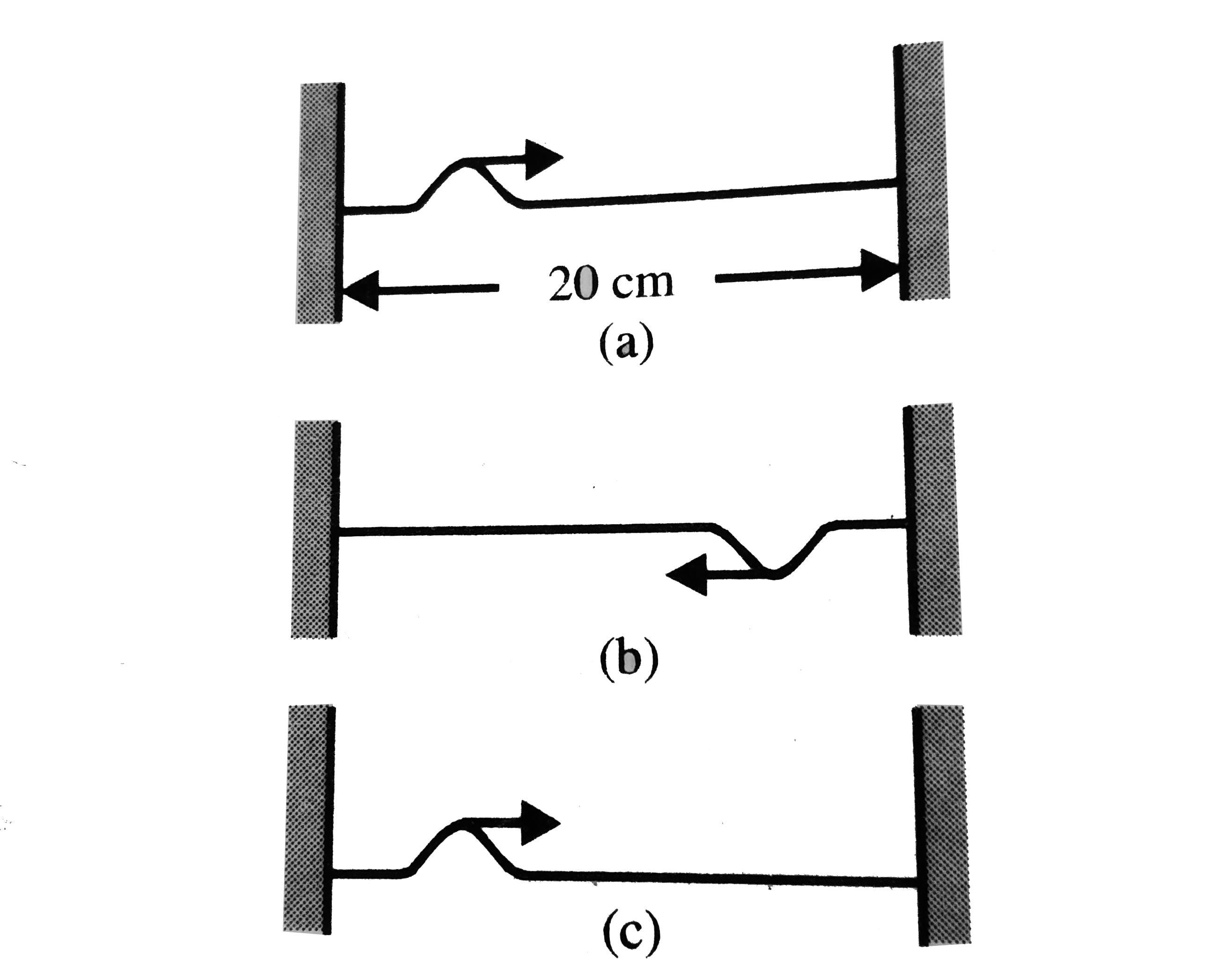 View Solution
View SolutionQuestion 15
A long wire PQR is made by joining two wires PQandQR of equal radii . Pq has length 4.8mandmass0.06kg. QR has a length 2.56m and mass 0.2kg. The wire PQR is under a tension of 80N . A sinusoidal wave pulse of amplitude 3.5cm is sent along the wire PQ from the end? No power is dissipated during the propagation of the wave - pulse . Calculate
(a) The time taken by the wave pulse to reach the order end R of the wire , and
(b) The amplitude of the reflected and transmitted wave pulses after the incident wave pulse crosses the joint Q.View SolutionQuestion 16
A harmonic wave is travelling on string 1. At a junction with string 2 it is partly reflected and partly transmitted . The linear mass density of the second string is four times that of the first string , and that the boundary between the two strings is at x=0 . If the expression for the incident wave is yi=Aicos(k1x−ω1t).
What are the expressions for the transmitted and the reflected waves in terms of Ai,K1andω1?
(b) Show that the average power by the incident wave is equal to the sum of the average power carried by the transmitted and reflected waves . View SolutionQuestion 19
Two travalling wavews of equal amplitudes and equal frequencies move in opposite directions along a string. They interfere to produce a standing wave having the equation y=Acoskxsinωt in which A=1.0mm,k=1.57cm−1andω=78.5s−1 (a) Find the velocity of the component travelling waves. (b) Find the node closet to the origin in the x gt 0. (c ) Find the antinode closet to the origin in the region x gt 0 (d) Find the amplitude of the particle at x = 2.33cm.View SolutionQuestion 21
Two sinusoidal waves combining in a medium are described by the wave functions
y1=(3.0cm)sinπ(x+0.60t)
y2=(3.0cm)sinπ(x−0.60t)
where x is in centimeters and t is in seconds . Determine the maximum transverse position of an element of the medium at (a) x=0.250cm , (b) x=0.500cm and (c ) x=1.50cm. (d) Find the three smallest values of x corresponding to antinodes.View SolutionQuestion 24
The fundamental frequency of a sonometer wire increases by 6Hz if its tension is increased by 44% keeping the length constant. Find the change in the fundamental frequency of the sonometer when the length of the wire is increased by 20% keeping the original tension in the wire.View SolutionQuestion 27
Two metallic strings AandB of different materials are connected in series forming a joint . The strings have similar cross - sectional area .The length od AislA=0.3mandBislB=0.75m . One end of the combined string is tied with a support rigidly and the other end is loaded with a block of mass m passing over a frictionless pulley . Transverse waves are set up in the combined string using an external source of variable frequency , calculate
a. The lowest frequency for which standing waves are observed such that the joints is a node and
b. The total number of antinodes at this frequency . The densities of A and B are 6.3×103kg/m3and2.8×103kg/m3 , respectively . View SolutionQuestion 29
Middle C on a piano has a fundamental of 262Hz, and the first A above middle C has a fundamental frequency of 440Hz.
a. Calculate the frequencies of the next two harmonics of the C string .
b. If AandC, strings have the same linear mass density μ and length L, determine the ratio of tensions in the two strings . View SolutionQuestion 31
One end of a horizontal string is attached to a vibrating blade , and the other end passes over a pulley as in Fig. 7.49 (a). A sphere of mass 2.00kg hangs at the end of the string . The string is vibrating in its second harmonic . A container of water is raised under the sphere so that the sphere is completely submerged . In this configuration , the string vibrates in its fifth harmonic as shown in Fig . 7.49 (b). What is the radius of the sphere ?
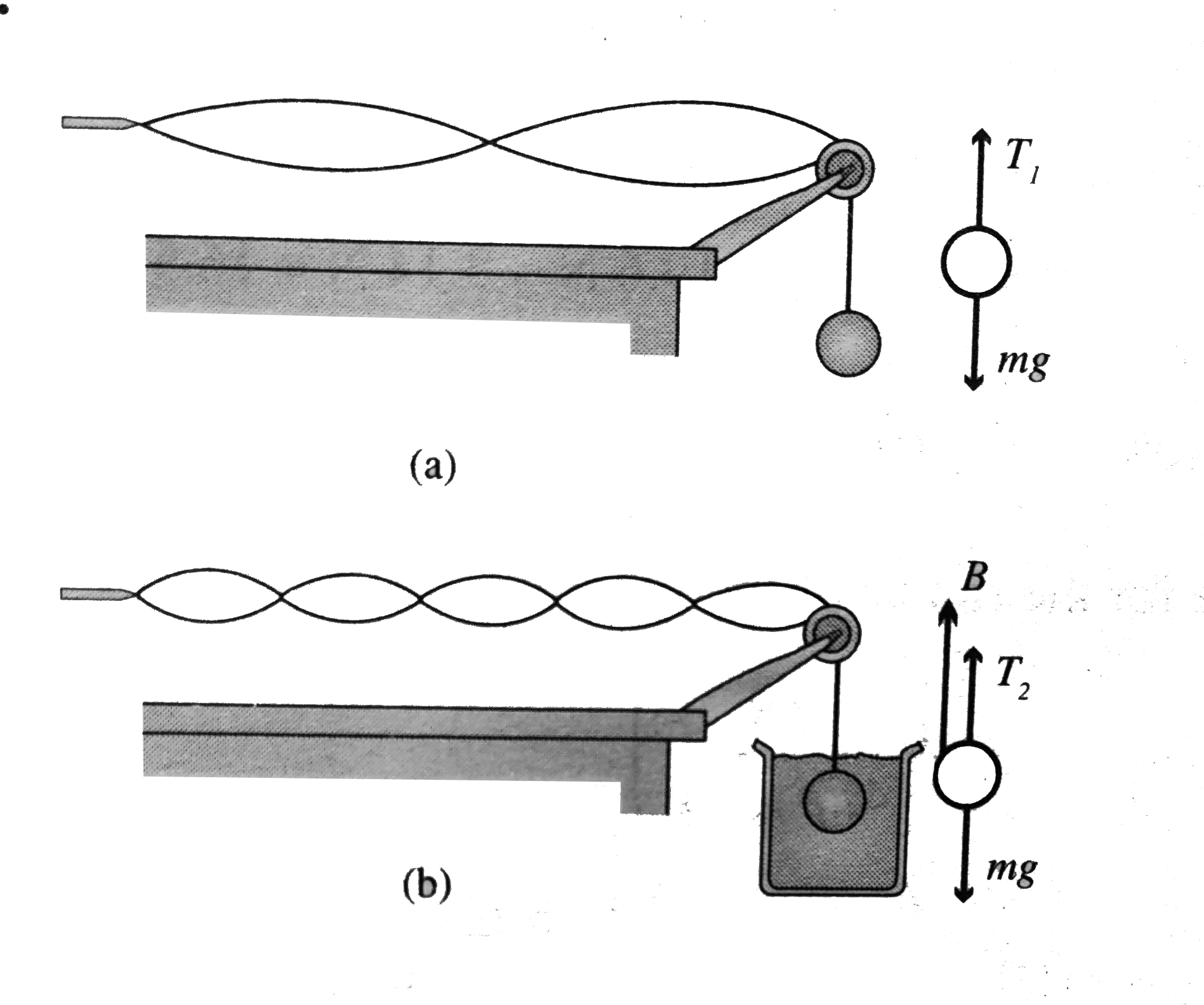 View Solution
View SolutionQuestion 33
A shower stall has dimensions 86.0cm×86.0cm×210cm. If you singing in this shower , which frequencies would sound the richest ( because of resonance) ? Assume the stall acts as a pipe closed at both ends , with nodes at opposite sides . Assume the voices of various singers range from 130Hzto2000Hz. Let the speed of sound in the hot air be 355m/s.View SolutionQuestion 34
A section of driange culvert 1.23m in length makes a howling noise when the wind blows across its open ends .
a. Determine the frequencies of the first harmonics of the culvert , if it is cylindrical in shape and open at both ends . Take v=343m/s as the speed of sound in air .
b. What are the three lowest natural frequencies of the culvert if it is blocked at one end ?View SolutionQuestion 35
Find the number of possible natural oscillations of air column in a pipe frequencies of which lie below v0=1250Hz. The length of the pipe is l=85cm. The velocity of sound is v=340m/s. Consider two cases
i. the pipe is closed from the end ,
ii. the pipe is open from both ends. View SolutionQuestion 36
In a Kundt's tube experiment , with a wooden rod 170cm along , clamped at the middle , the lycopodium powder gets heated up at regular intervals of 13.4cm , the experiment being performed with air . If the frequency of vibrations be 1270Hz , find the velocity of sound in air and in the wooden rod.View SolutionQuestion 37
A Kundt's tube experiment is conducted with a 1m long glass rod , twice , one with air and the other with hydrogen , gas filled in the tube . In the first case , there were 11 heaps of lycopodium powder within a length of 64.4cm between the first and the last . The corresponding parameters in the second case are 5 nodal heaps within 99.7cm length.
Find the velocity of sound in glass and in hydrogen m if that in air be 335m/s. View SolutionQuestion 39
The first two lengths of an air column , in a resonance column method , were found to be 32.1cmand99.2cm , respectively . Determine the end correction for the tube . If it is known that velocity of sound in the laboratory is 332m/s , then find the frequency of the vibrating tunning fork.View SolutionQuestion 40
A simple apparatus for demonstrating resonance in an air column is depicted in Fig. 7.59.A vertical pipe open at both ends is partially submerge in water , and a tuning fork vibration at an unknown frequency is placed near the top of the pipe . The length L of the air column can be adjusted by moving the pipe vertically . The sound waves generated by the fork are reinforced of the pipe . For a certain pipe , the smallest value of L for which a peak occurs in the intensity is 9.00cm.
a. What is the frequency of the tuning fork ?
b. What are the values of L for the next two resonance conditions? View Solution
View SolutionQuestion 41
An air column in a glass tube , is open at one end and closed at the other by a movable piston . The air in the tube is warmed above room temperature , and a 384Hz tuning fork is held at the open end. Resonance is heard when the piston is 22.8cm from the open end and again when it is 68.3cm from the open end . (a) What speed of sodium is implied by these data ? (b) How far from the open end will the piston be when the next resonance is heard ? View SolutionQuestion 43
An aluminimum rod 1.60m long is held at its centre. It is stroked with a rosin - coated cloth to set up a longitudinal vibration. The speed of sound in thin rod of aluminium is 5100m/s. (a) What is the fundamental frequency of the waves established in the rod ? (b) What harmonics are set up in the rod held in this manner ? (c ) What would be the fundamental frequency if the rod were copper , in which the speed of sound is 3650m/s?View SolutionQuestion 45
A metal rod length l=100 cm is changed at two points A and B as shown in fig. Distance of each clamp from neared and is a=30 cm. if density and Young's modulus of elesticity of rod material are ρ=9000kg/m3 and Y=144Gpa, respectively, calculate minimum and next higher frequency of natural longitudinal oscillations of the rod.
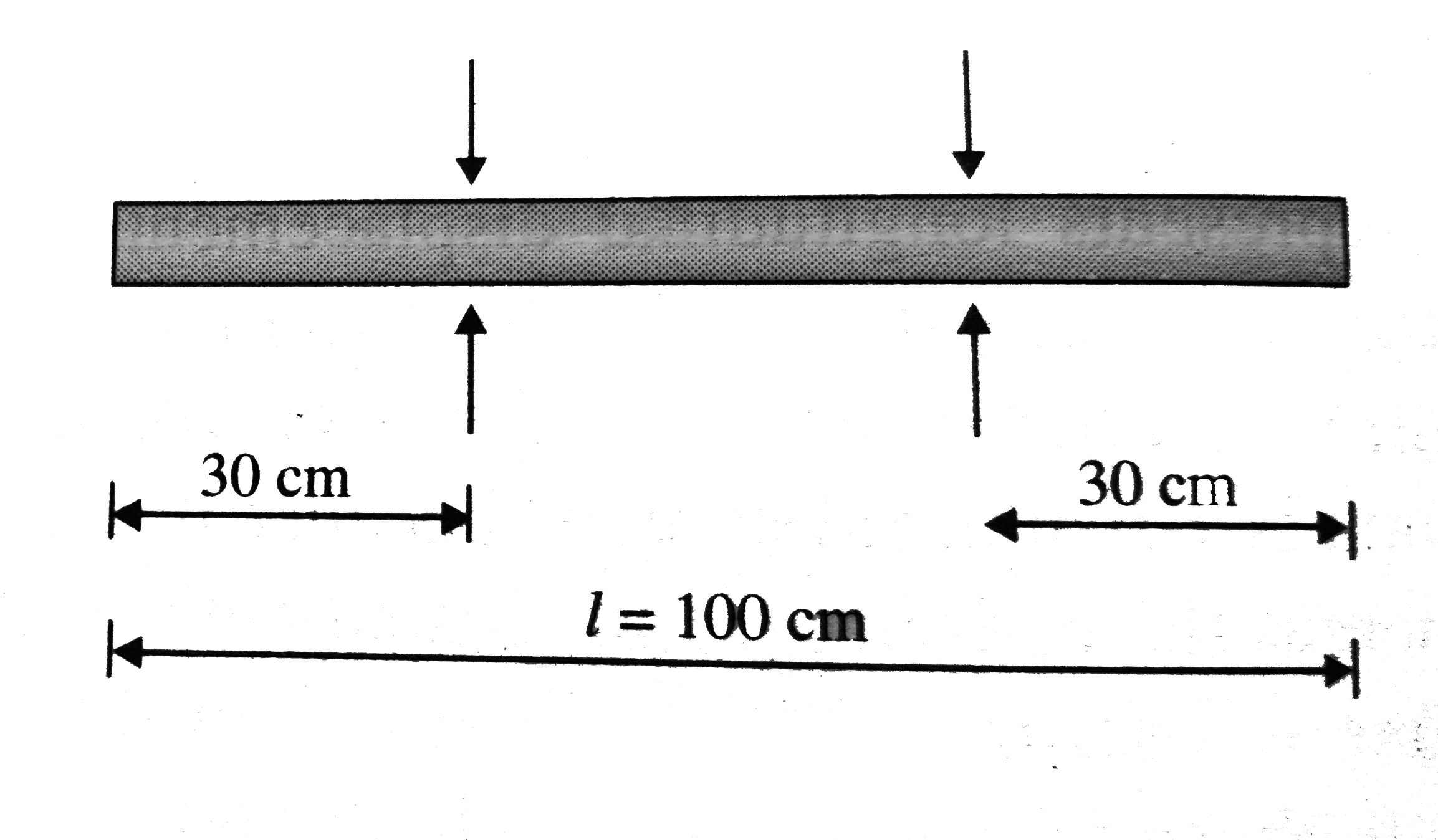 View Solution
View SolutionQuestion 48
In certain ranges of a piano keyboard , more than one string is tuned to the same note to provide extra loudness . For example , the note at 110Hz has two strings at this frequency . If one string slips from its normal tension of 600Nto540N , what beat frequency is heard when the hammer strikes the two strings simultaneously ?View SolutionQuestion 49
Two wires are together end to end . The wires are made of the same material , but the diameter of one is twice that of the other . They are subjected to a tension of 4.60N. The thin wire has a length of 40.0cm and a linear mass density of 2.00g/m. The combination is fixed at both ends and vibrated in such a way that two antinodes are present , with the node between them being precisely at the weld . (a) What is the frequency of vibration ? (b) Find the length of the thick wire . View SolutionQuestion 50
A standing wave is set up in a string of a variable length and tension by a vibrator of variable frequency . Both ends of the string are fixed . When the vibrator has a frequency f , in a string of length L and under tension T,n antinodes are set up in the string is doubled , by what factor should the frequency be changed so that the same number of antinodes is produced? (b) If the frequency and lenght are held constant , what tension will produce n+1 antinodes ? ( c) If the frequency is tripled and the length of the string is halved , by what factor should the tension be changed so that twice as many antinodes are produced ? View SolutionQuestion 52
Two radio stations broadcast their programmes at the same amplitude A, and at slightly different frequencies ω1andω2 respectively , where ω2−ω1=103Hz. A detector receives the signals from the two stations simultaneously . It can emit signals only of intensity ≥2A2.
(i). Find the time intervals between successive maxima of the intensity of the signal received by the detector .
ii. Find the time for which the detector remains idle in each cycle of the intensity of the signal .View SolutionQuestion 53
A metal wire of diameter 1mm is held on two knife by a distance 50cm . The tension in the wire is 100N. The wire vibrating with its fundamental frequency and a vibrationg tuning fork together produce 5beats/s. The tension in the wire is then reduced to 81N. When the two excited , beats are heard at the same rate .
Calculate
i. the frequency of the fork and
ii. the density of material of wire View SolutionQuestion 54
An aluminimum wire of cross - sectional area 1×10−6m2 is joined to a steel wire of the same cross - sectional area . This compound wire is stretched on a sonometer , pulled by a weight of 10kg. The total length of the compound wire between the bridges is 1.5m of which the aluminium wire is 0.6m and the rest is steel wire . Transverse vibrations are set up in the wire by using an external source of variable frequency . Find the lowest frequency of excitation for which standing waves are formed , such that the joint in the wire is a node . What is the total number of nodes observed at this frequency , excluding the two at the ends of the wire ? The density of aluminium is 2.6×103kg/m3 and that of steel is 1.04×104kg/m3View SolutionQuestion 55
A uniform rope of length 12m and mass 6kg hangs vertically from a rigid support . A block of mass 2kg is attached to the free end of the rope . A transverse pulse of wavelengths 0.06m is produced at the lower end of the rope . What is the wavelength of the pulse when it reaches the top of the rope?View SolutionQuestion 56
The vibrations of a string of length 60cm fixed at both ends are represented by the equation
y=4sin(πx15)cos(96πt)
where x and y are in cm and t in second .
ii. Where are the nodes located along the strings ?
iii. What is the velocity of the particle at x=7.5cmatt=0.25s?
iv. Write down the equations of component waves whose superposition gives the above waves . View SolutionQuestion 58
The air in a pipe closed at one end is made to vibrate in its second overtone by a tuning fork of frequency 440Hz. The speed of sound in a 330m/s. End correction may be neglected . Let P0 denotes the mean pressure of any point in the pipe and ΔP0 the maximum amplitudes of pressure variation.
a. Find the length L of the air column.
b. What is the amplitude of pressure variation at the middle of the column
c. What are maximum and minimum pressures at the open end of the pipe ?View SolutionQuestion 59
AB is a cylinder of length 1.0m fitted with a thin flexible diaphragm C at the middle and two others thin portions ACandBC contains hydrogen and oxygen gases , respectively . The diaphragms AandB are set into vibrations of same frequency . What is the minimum frequency of these vibrations for which the diaphragm C is a node ? Under the conditions of the experiment , the velocity of sound in hydrogen is 1100m/s and in oxygen is 300m/s.
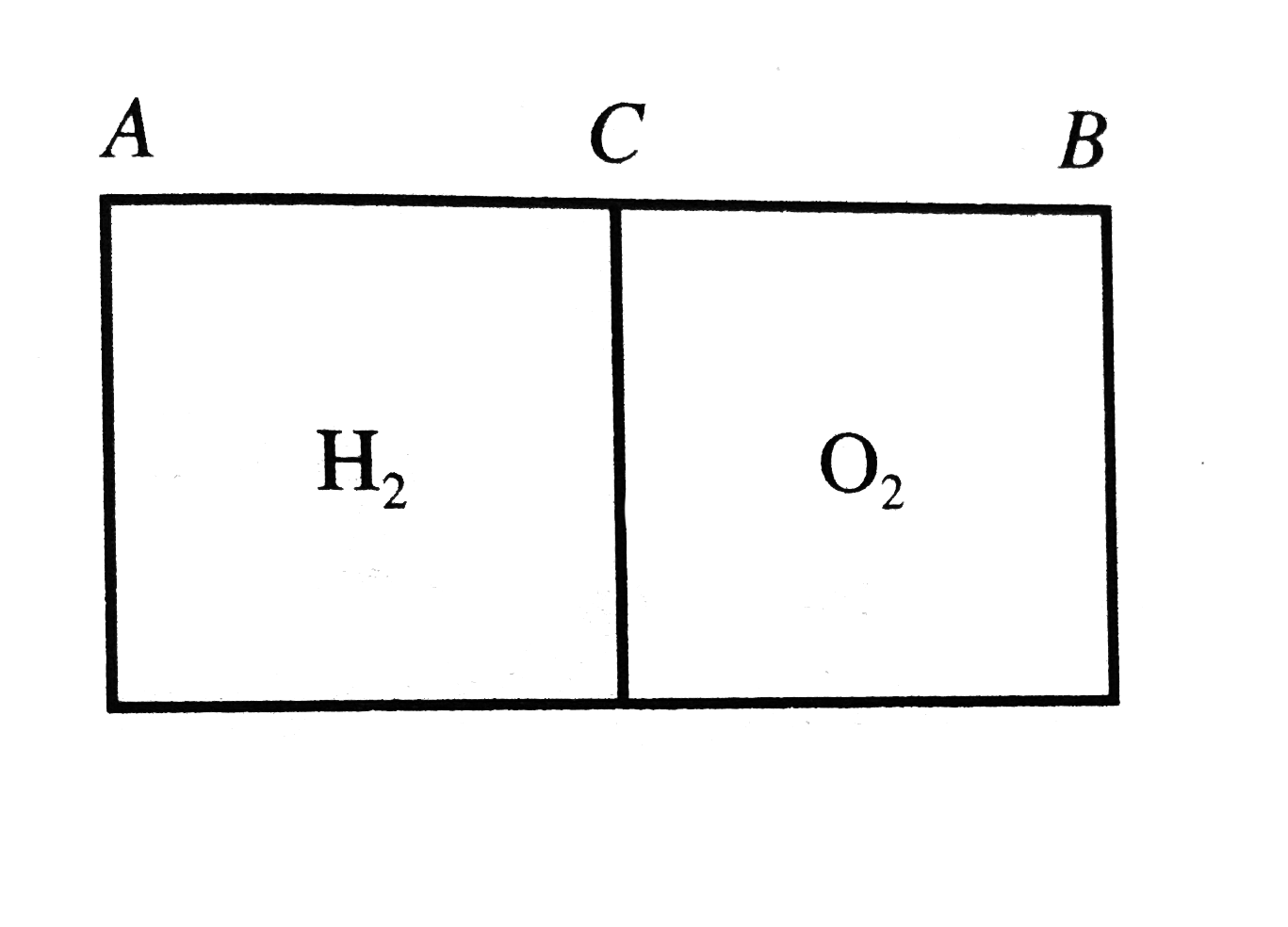 View Solution
View SolutionQuestion 61
Two narrow cylindrical pipes AandB have the same length . Pipe A is open at both ends and is filled with a monoatomic gas of molar mass MA. Pipe B is open at one end and closed at the other end and is filled with a diatomic gas of molar mass MB. Both gases are at the same temperature .
a. If the frequency to the second harmonic of the fundamental mode in pipe A is equal to the frequency of the third harmonic of the fundamental mode in pipe B, determine the value of MA/MB.
b. Now the open end of pipe B is also closed ( so that pipe B is closed at both ends ). Find the ratio of the fundamental frequency in pipe A to that in pipe B. View Solution
